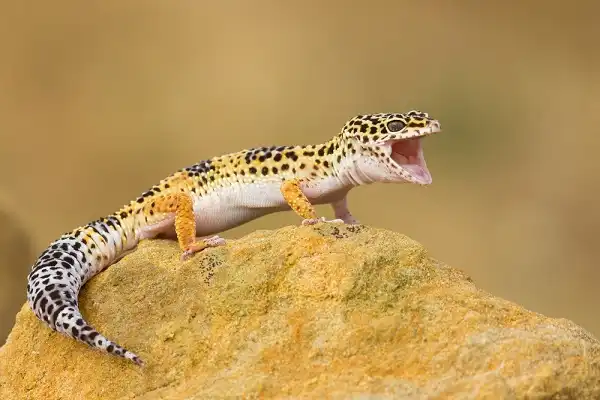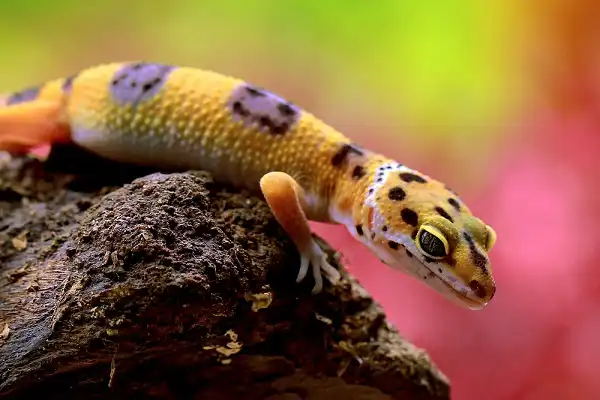Whether you’re simply looking for a new pet, or you’re a budding herpetologist, the leopard gecko is a great choice. These lizards are relatively easy to care for and make great first-time pets. In this article, we’ll cover everything you need to know about leopard geckos, including their natural habitat, diet, and behaviors. So read on to learn more about these amazing creatures!

Leopard Gecko Description
Leopard geckos are small, ground-dwelling lizards. The most recognizable feature of the leopard gecko is its spotted or banded skin pattern, which varies among different individuals. The most common pattern is yellowish-brown with black spots, although some may be paler and some may also possess a pink hue. Leopard geckos also have a short tails that can be easily regenerated if lost due to predation or territorial disputes. Colors range from olive green to yellow and even red with darker spots that give them their unique name of “leopard” gecko!
Leopard Gecko Habitat
Leopard geckos are native to the arid parts of Southwestern Asia and Northwest India. This environment is generally dry, rocky, and sandy, with low vegetation cover. In the wild, they make their home in shallow burrows they have created themselves or have found amongst the rocks and crevices in the region. These lizards require a warm and dry habitat that mimics their natural environment as closely as possible. A well-made terrarium is ideal for them because it allows for better temperature control, ventilation, and humidity levels. It should include elements that replicate their natural environment like branches for a climbing, substrate for digging and hiding, flat rocks to bask on during the day, and decorations that can provide shelter from bright light or hide food items.
The substrate should also be chosen carefully depending on what type of gecko you own. Sand should be avoided due to its lack of absorbency which can cause respiratory infections if inhaled by your pet lizard. Leopard geckos also need a high humidity level in their enclosure since they originated from these hot climates. Too much humidity, however, can cause health issues so a humidifier must be used accordingly while checking periodically with a hygrometer to make sure the levels stay within the normal range (30%-50%). Furthermore, an artificial light source is recommended since they are nocturnal animals; this will help them regulate their body temperatures and prevent any potential stress or health complications associated with living in unnatural lighting conditions such as too much heat or too little UVB rays.

Leopard Gecko Diet
Leopard geckos are primarily insectivorous, meaning they feed mostly on insects like crickets, beetles, roaches, grasshoppers, and moths. However, they will also eat small vertebrates such as baby mice on occasion. It is important to note that these lizards require a balanced diet to ensure proper nutrition. In order to maintain the health of your pet gecko, it is imperative to provide them with a variety of food items including both live and frozen insects such as crickets, mealworms, wax worms, and super worms. If fed live prey items, make sure they are no bigger than half the size of the lizard’s head in order not to cause choking or other digestive issues. Additionally, dusting all food items with a good quality calcium supplement is recommended at least twice a week in order for the gecko to get enough minerals into their body.
Vitamins can also be added if desired or necessary depending on the age and general health condition of your pet gecko. It is important to note that leopard geckos have low metabolic rates which means that they do not need feeding every day; instead, 2-3 times per week would suffice for an adult gecko. However, if you have a juvenile lizard then it should be given more frequent feedings (4-5 times per week). Younger lizards require larger amounts of food because their bodies are still growing and developing so keep this in mind when providing nourishment for your pet! On top of this regular dietary plan for your leopard gecko, you should also provide fresh water daily in clean bowls or dishes that cannot easily be tipped over by the lizard’s movements within its enclosure. This will help keep them hydrated and healthy as well as prevent any potential stress-related illnesses due to living in unnatural environments with inadequate water sources available.
Leopard Gecko Size
Leopard geckos are amongst the smallest species of lizards in the world, typically ranging from 5 to 7 inches (12-17 cm) in length. They can weigh anywhere between 1 and 4 ounces (30-110 g), depending on their age, sex, and overall health condition. Their appearance can vary as well; males tend to be bigger and stockier with more pronounced heads and ridges along their backs compared to females who usually have more slender bodies and smoother skin. However, it is important for owners to keep an eye on their pet’s size since this could indicate potential health problems. For instance, underfeeding or overfeeding can lead to stunted growth or obesity which can have negative implications for your lizard’s lifespan down the road.
Leopard Gecko Lifespan
Leopard geckos can live up to 20 years if they are provided with proper care and nutrition, making them one of the longest-living among lizards. Furthermore, their hardy nature allows them to survive in a wide variety of temperatures ranging from 65°F – 85°F (18°C – 29°C), making it easier for them to thrive in captivity. In terms of age, the leopard gecko’s lifespan depends on its overall health condition as well as its diet. For instance, an adult gecko that is properly fed and taken care of can live up to 15 years while those who are unhealthy and malnourished can have a significantly shorter lifespan. In addition, female leopard geckos tend to live longer than males due to their generally smaller size and less aggressive behavior.

Leopard Gecko Behavior
Leopard geckos are nocturnal animals, meaning that they are most active at night and sleep during the day. During the night they will typically hunt for small insects such as mealworms, waxworms, and crickets which make up their main diet. They are also known to be quite social creatures and enjoy interacting with their owners and other geckos in their tanks. Leopard geckos have a variety of behaviors that can help them survive and thrive in the wild. One behavior is thermoregulation, which is when they adjust their body temperature according to their environment by moving from warmer areas to cooler ones throughout the day or night in order to stay within an optimal temperature range for survival.
This allows them to remain alert, feed more efficiently and avoid predators. Another behavior is their territorial nature; leopard geckos often establish territories both inside and outside of their enclosure where they will defend against intruders or strangers who enter it. Owners should take note of these signs as they could indicate that the leopard gecko is feeling threatened or simply asserting dominance over its territory. Additionally, leopard geckos may display certain behaviors such as tail waving or bobbing while searching for prey or competing with others. Tail waving is done by rapidly twisting the tail side-to-side in order to detect vibrations in the air around them which helps them locate food sources hidden behind rocks or logs where most of their prey reside during the daylight hours.
Leopard Gecko Speed
Leopard geckos are quite fast creatures and can reach speeds of up to 15 mph when running away from predators in the wild. However, this speed is only achievable on a flat and even terrain; if the ground is rocky or uneven, it will slow down significantly. Furthermore, they possess an excellent sense of timing and coordination which allows them to move quickly without tripping over obstacles or getting caught in trees or foliage. Leopard geckos also have a unique ability to climb vertically, meaning that they can reach heights of up to 6 feet in just seconds! They achieve this by using their strong legs and toes as well as their sharp claws to help them dig into surfaces like wooden posts or tree trunks. Additionally, their long tails provide them with additional balance and support during the climb allowing for a rapid ascent. When kept as pets, leopard geckos usually do not display the same level of speed since they feel more secure in their comfortable environment than when faced with threats out in the wild. Nevertheless, owners should still provide ample space for exercise within the enclosure so that their pet lizards can stretch those legs out now and then!
Leopard Gecko Hunting
Leopard Gecko Hunting is an essential part of the reptile’s survival in the wild. They rely on their keen senses and agility to track down prey hidden away in crevices or behind rocks. The geckos will use their powerful legs, sharp claws, and even longer tails to climb on posts or trees, giving them a better vantage point when searching for food. Their acute vision also helps them spot small insects like mealworms and waxworms from afar while their heightened sense of smell allows them to pick up scents such as other animals or food sources. Furthermore, they possess lightning-quick reflexes that help them pounce quickly before their prey can dart away. Along with this, leopard geckos are known to be quite sly in their hunting techniques; they often approach their intended target from a side angle so as not to alert any potential predators nearby.

Leopard Gecko Health Care
As with all reptiles, it is important to ensure that proper health care is provided to your pet leopard gecko. This includes regular check-ups by an experienced veterinarian who can detect any potential issues early on and provide the necessary treatment. Owners should also be aware of what signs to look out for in order to identify potential health problems such as changes in behavior or appearance, weight loss or gain, respiratory difficulty, vomiting, or any other odd symptoms. Furthermore, owners should make sure to keep their enclosure clean and provide a healthy diet regularly so that their pet reptile has all the necessary nutrients for optimal health.
Conclusion
Leopard geckos are renowned for their agility and hunting prowess making them one of the most formidable reptiles around. Their powerful legs, sharp claws, and even longer tails help them climb quickly on posts or trees to gain a better vantage point when searching for food. Furthermore, they possess lightning-quick reflexes that enable them to strike down prey items with precision and accuracy. When kept as pets, owners should ensure that these lizards have ample space for exercise within the enclosure so that they can stretch out those legs now and then! Furthermore, it is important to only offer pre-killed foods like crickets to avoid overstimulating your pet reptile leading to injuries among themselves or other living creatures inside the enclosure. With this information in mind, you can easily provide leopard geckos with the perfect environment for a healthy and long life.
Frequently Asked Question


